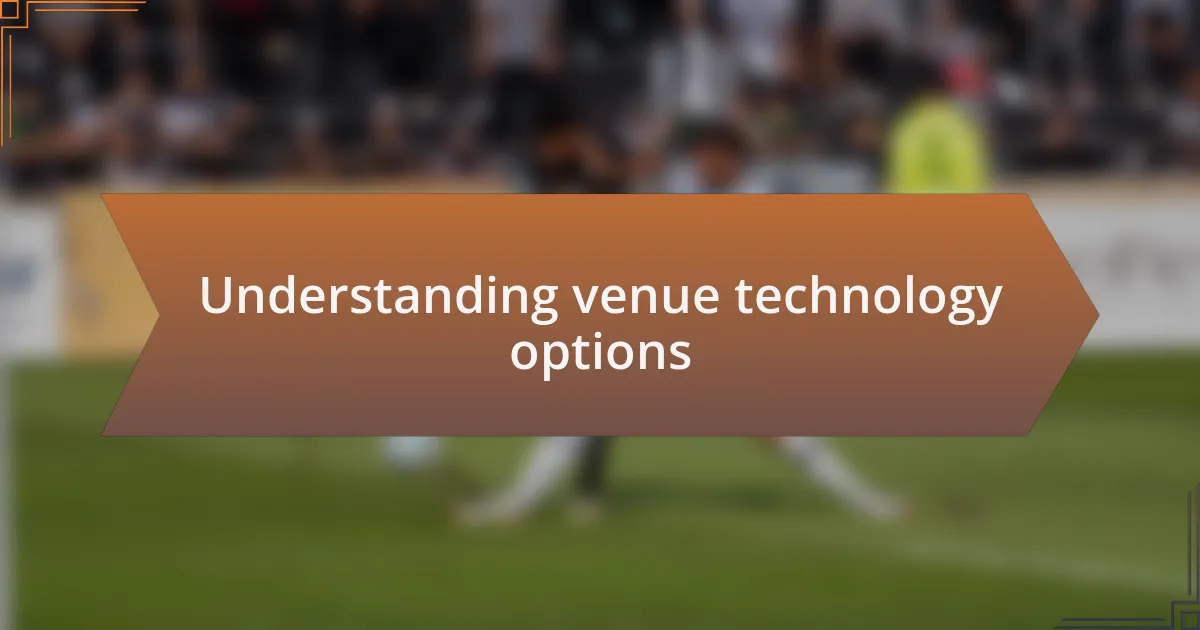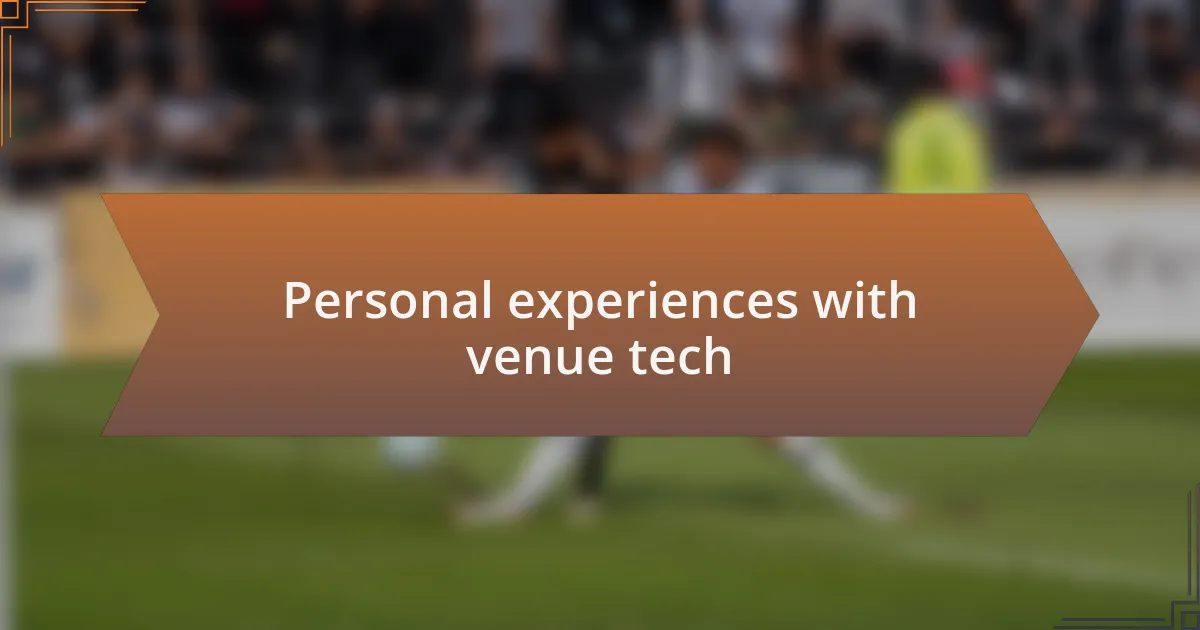Key takeaways:
- Selecting high-quality audio-visual equipment and ensuring strong connectivity are crucial for enhancing audience engagement during events.
- Evaluating tech needs should prioritize audio quality, content type, and the technical skills of the team to avoid issues and enhance the attendee experience.
- When assessing vendor proposals, focus on their ability to meet specific tech needs and evaluate support availability alongside cost versus value.
- Hands-on testing of venue tech and having contingency plans are essential to avoid disruptions and ensure a smooth experience during events.

Understanding venue technology options
When it comes to venue technology options, understanding what’s available can make all the difference. I remember attending a conference where the seamless integration of audio-visual equipment transformed the experience. Have you ever felt frustrated when the tech falters? Selecting the right tools, like high-quality projectors and reliable sound systems, ensures that both presenters and attendees remain engaged.
Exploring different venue technologies also means considering the setup that enhances connectivity. I once held an event in a space lacking strong Wi-Fi, and it left many participants feeling disconnected. It’s essential to evaluate options like high-speed internet access and tech support on-site. How often do we overlook the basic necessities until they become an issue? By prioritizing connectivity, you create an environment where everyone feels involved and empowered.
Lastly, don’t underestimate the power of interactive elements such as audience response systems or live streaming capabilities. I’ve seen how these features can completely transform the energy of an event, making the audience feel like part of the conversation. Have you thought about how technology can stimulate engagement? With the right venue tech, you not only elevate the event experience but also foster collaboration and interaction in ways that can leave a lasting impact.
Assessing your event’s tech needs
When assessing your event’s tech needs, I often start by envisioning the audience’s experience from their perspective. I remember hosting a workshop where we relied on a simple laptop setup, only to realize halfway through that participants were straining to hear from the back. Have you ever been in a room where the sound was just too low to engage? This experience highlighted my need to prioritize audio quality over aesthetics, reinforcing the idea that the tech must serve the audience first.
Another key aspect to consider is the type of content you plan to present. I once took part in an event where a panel discussion was accompanied by intricate video presentations. The technical glitches were not only distracting but also impacted audience engagement. Have you considered how the format influences your tech choices? Depending on whether your event is interactive or presentation-focused, your tech needs can vary significantly, so it’s vital to tailor your selection accordingly.
Lastly, don’t forget to account for the technical skills of your team. I’ve worked with both seasoned tech professionals and novices, and the difference can be night and day. Have you thought about who will operate the equipment? A reliable tech team can handle unexpected challenges smoothly, while a lack of familiarity can lead to chaos. Assessing your team’s capabilities helps ensure that your tech setup supports your event’s goals rather than becoming a source of frustration.

Evaluating vendor proposals effectively
When I sit down to evaluate vendor proposals, I always focus on their ability to meet my specific tech needs. There’s this one time I received a proposal that looked terrific on paper but fell short in real life when we tested their equipment. This led me to ask, how well does the vendor really understand the unique demands of my event? I find that asking for examples from their past work can reveal not just their experience, but also their creative problem-solving skills.
What really helps me sift through proposals is knowing what questions to ask. I remember when I overlooked clarifying support availability during a major event, leading to frantic calls for help when issues arose. Have you thought about how easily you can reach someone in the heat of the moment? Ensuring that vendors provide clear information about their support, response times, and backup plans can expose any weaknesses in their proposal.
Lastly, I often compare costs with value. I recall going for a lower-priced vendor only to realize that the lack of quality left my guests unimpressed. Have you considered that the cheapest option might not always be the best value? It’s crucial to weigh the benefits each vendor offers against their price, aiming for a balance that meets both budget constraints and quality expectations.

Personal experiences with venue tech
When it comes to venue tech, I’ve had my fair share of surprises. I remember one event where we were promised cutting-edge audio visual equipment, only to find that the sound system was not only outdated but also poorly positioned. It made me realize how critical it is to physically inspect the tech setup beforehand. Have you ever had a similar experience where tech issues undermined the event atmosphere? That experience taught me to prioritize hands-on testing in venue walk-throughs.
On another occasion, we opted for a venue that boasted wireless internet connectivity, which is crucial for modern events. However, when the day came, the connection dropped repeatedly, leaving speakers struggling to share their presentations. The chaos was stressful, and it left a lasting impression on our attendees. This has led me to advocate for a backup plan, like having a reliable wired option ready to go. What measures do you have in place to ensure tech reliability at your events?
One time, I paired with a vendor who utilized a new event management app that promised a seamless check-in experience. Initially, I was excited about the efficiency it would bring, but during the event, app glitches caused frustration among guests. I found myself wishing I had a traditional backup check-in method available. This made me question my reliance on technology—what if it fails when you need it most? Now, I always prepare a contingency plan that incorporates both high-tech and low-tech solutions.